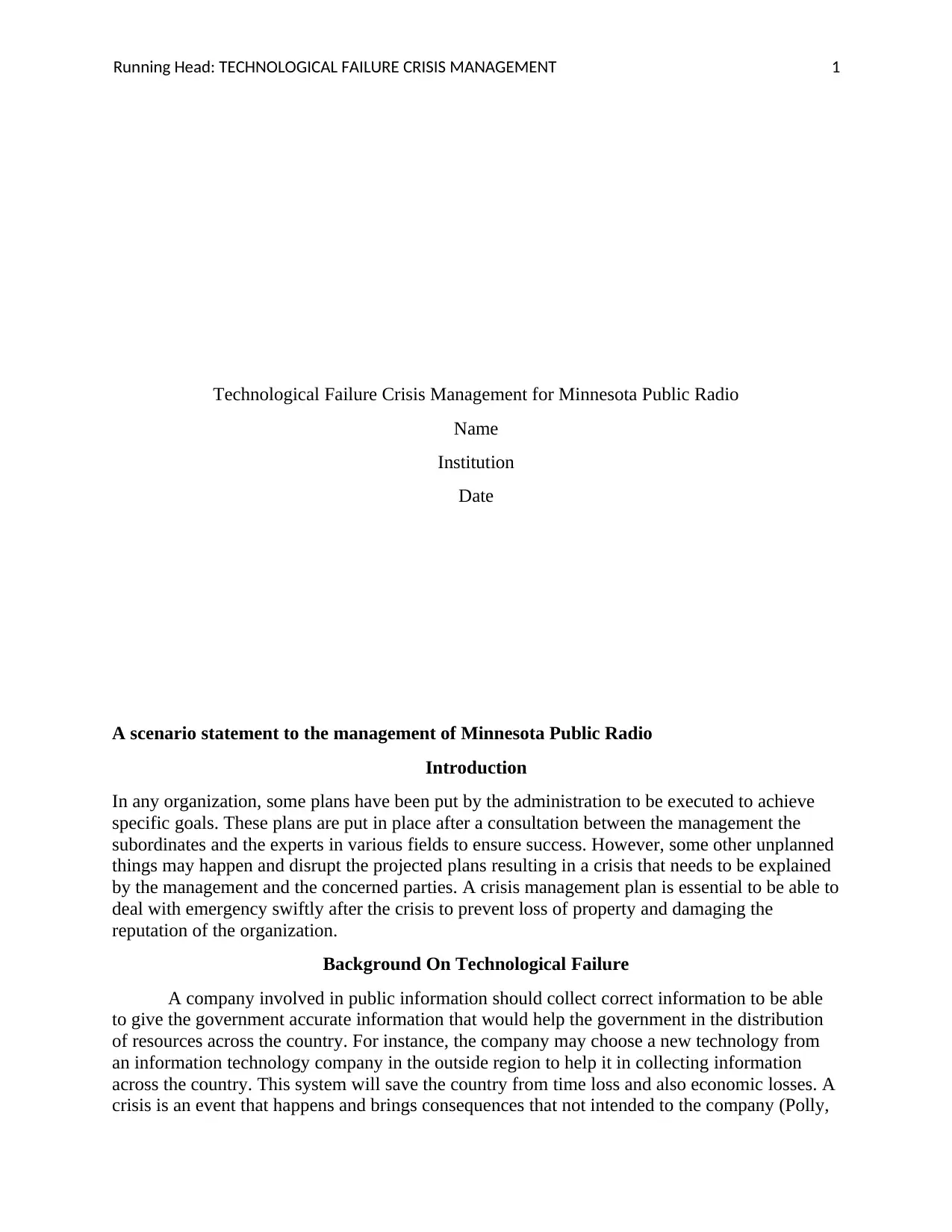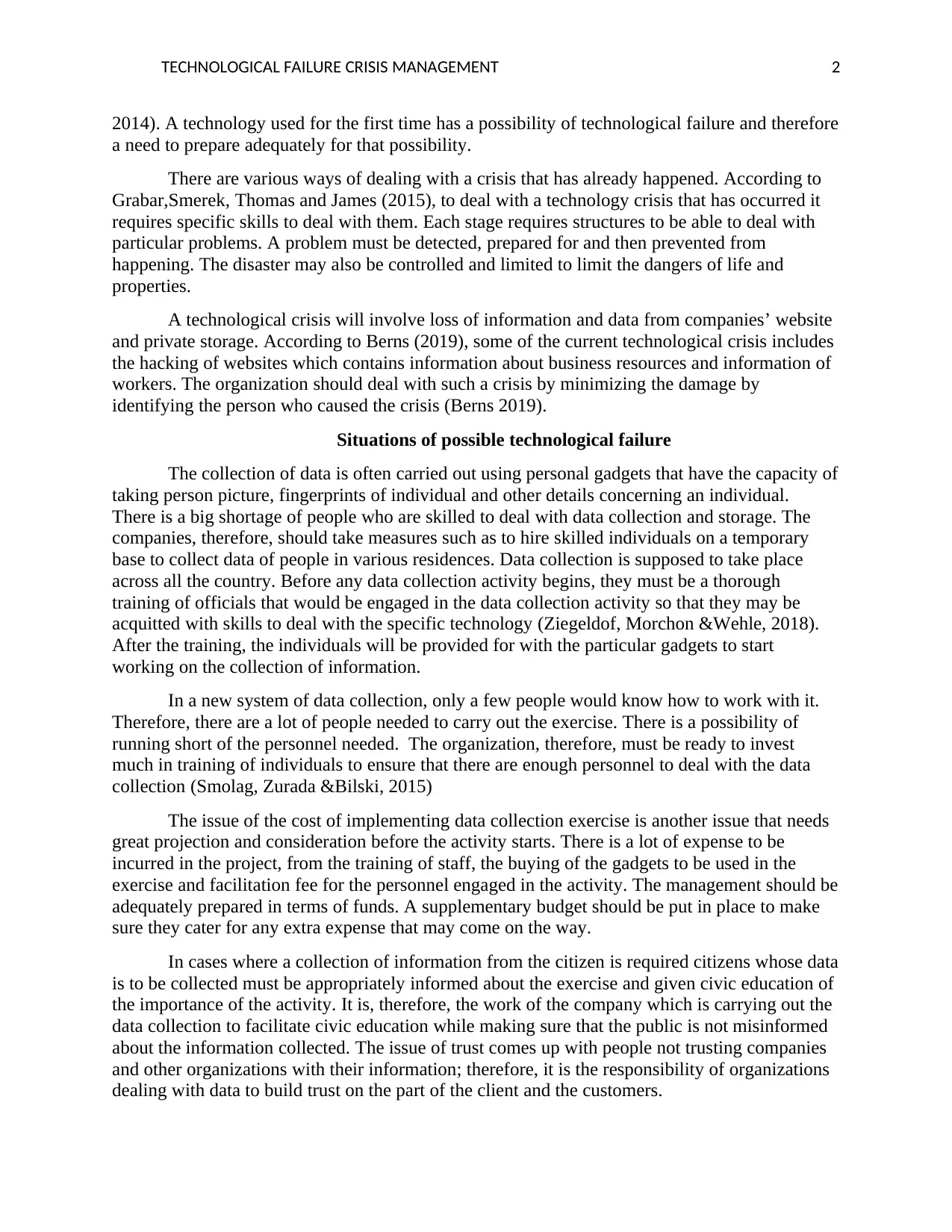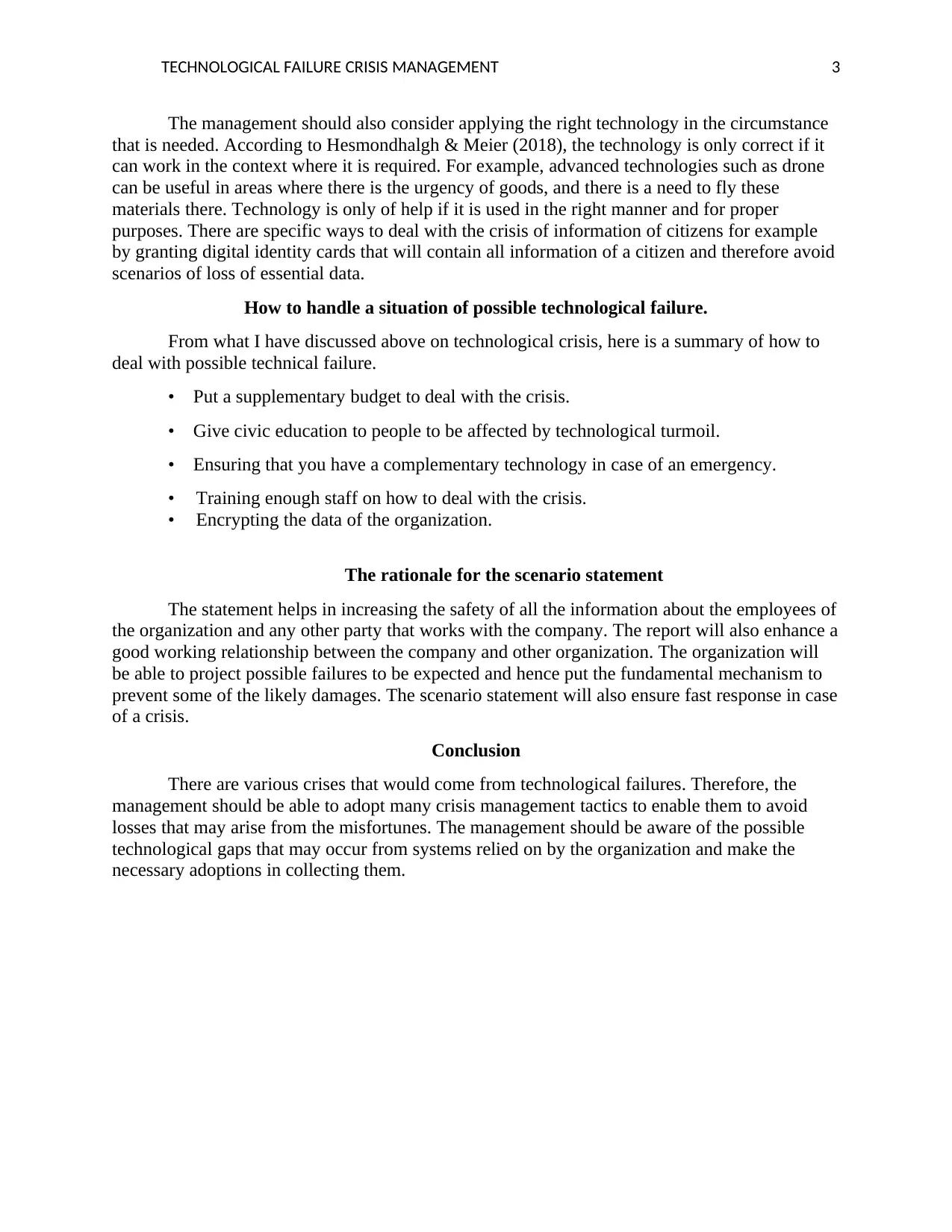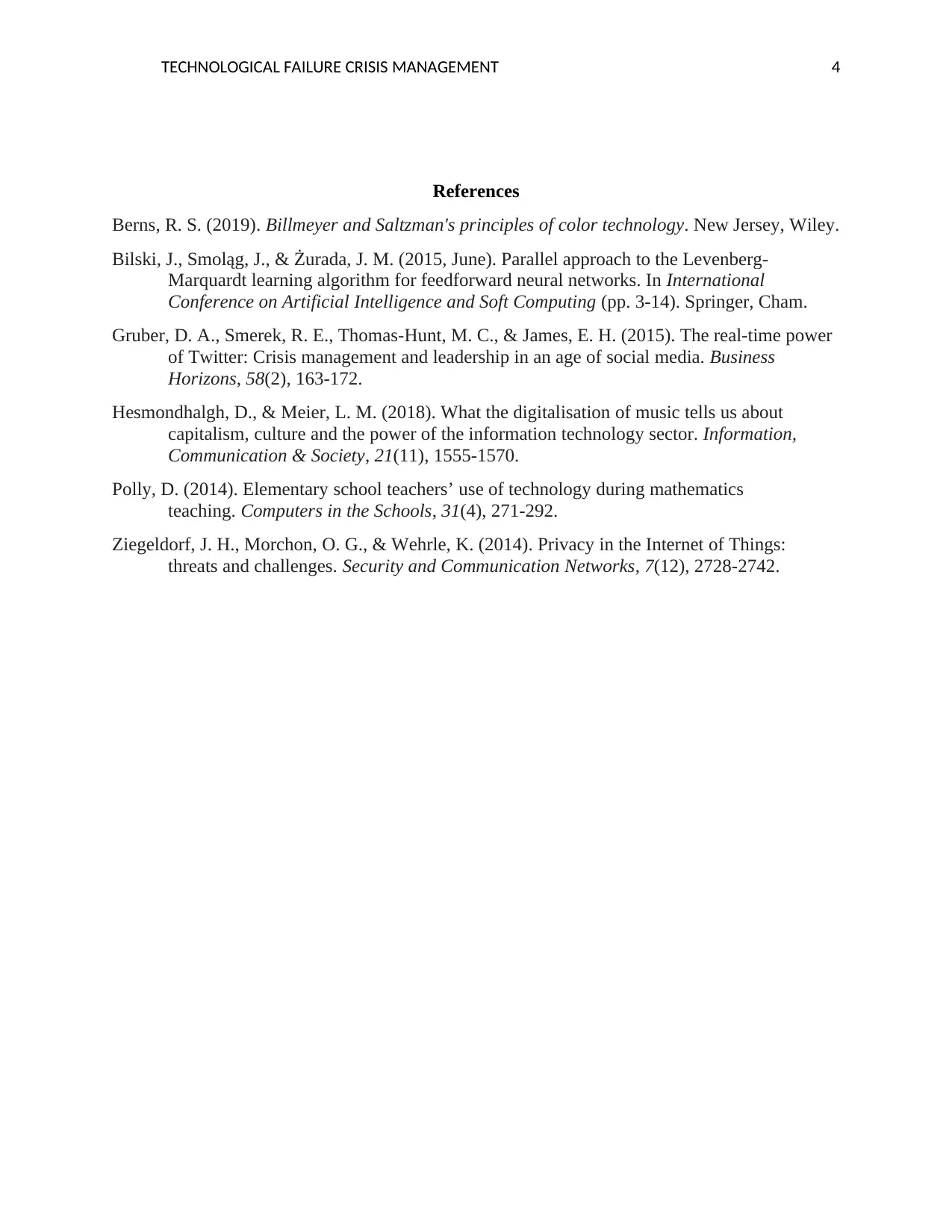Crisis Management Report: Technological Failures at Public Radio
VerifiedAdded on 2023/04/21
|4
|1515
|64
Report
AI Summary
This report addresses the critical issue of technological failure crisis management within Minnesota Public Radio. It highlights the importance of proactive planning to mitigate potential disruptions caused by technology malfunctions or cyberattacks. The report emphasizes the need for a well-defined crisis management plan, encompassing detection, preparation, prevention, and control measures. It identifies potential scenarios of technological failure, such as data loss, system hacking, and personnel shortages, and proposes strategies for handling these situations. These strategies include supplementary budgeting, public education, backup technology, staff training, and data encryption. The report underscores the significance of data security, trust-building with the public, and the appropriate application of technology. Ultimately, it aims to enhance the organization's resilience in the face of technological crises, ensuring the safety of information, fostering positive relationships, and enabling rapid response to unforeseen events. Desklib provides students access to similar solved assignments and resources.

Running Head: TECHNOLOGICAL FAILURE CRISIS MANAGEMENT 1
Technological Failure Crisis Management for Minnesota Public Radio
Name
Institution
Date
A scenario statement to the management of Minnesota Public Radio
Introduction
In any organization, some plans have been put by the administration to be executed to achieve
specific goals. These plans are put in place after a consultation between the management the
subordinates and the experts in various fields to ensure success. However, some other unplanned
things may happen and disrupt the projected plans resulting in a crisis that needs to be explained
by the management and the concerned parties. A crisis management plan is essential to be able to
deal with emergency swiftly after the crisis to prevent loss of property and damaging the
reputation of the organization.
Background On Technological Failure
A company involved in public information should collect correct information to be able
to give the government accurate information that would help the government in the distribution
of resources across the country. For instance, the company may choose a new technology from
an information technology company in the outside region to help it in collecting information
across the country. This system will save the country from time loss and also economic losses. A
crisis is an event that happens and brings consequences that not intended to the company (Polly,
Technological Failure Crisis Management for Minnesota Public Radio
Name
Institution
Date
A scenario statement to the management of Minnesota Public Radio
Introduction
In any organization, some plans have been put by the administration to be executed to achieve
specific goals. These plans are put in place after a consultation between the management the
subordinates and the experts in various fields to ensure success. However, some other unplanned
things may happen and disrupt the projected plans resulting in a crisis that needs to be explained
by the management and the concerned parties. A crisis management plan is essential to be able to
deal with emergency swiftly after the crisis to prevent loss of property and damaging the
reputation of the organization.
Background On Technological Failure
A company involved in public information should collect correct information to be able
to give the government accurate information that would help the government in the distribution
of resources across the country. For instance, the company may choose a new technology from
an information technology company in the outside region to help it in collecting information
across the country. This system will save the country from time loss and also economic losses. A
crisis is an event that happens and brings consequences that not intended to the company (Polly,
Paraphrase This Document
Need a fresh take? Get an instant paraphrase of this document with our AI Paraphraser

TECHNOLOGICAL FAILURE CRISIS MANAGEMENT 2
2014). A technology used for the first time has a possibility of technological failure and therefore
a need to prepare adequately for that possibility.
There are various ways of dealing with a crisis that has already happened. According to
Grabar,Smerek, Thomas and James (2015), to deal with a technology crisis that has occurred it
requires specific skills to deal with them. Each stage requires structures to be able to deal with
particular problems. A problem must be detected, prepared for and then prevented from
happening. The disaster may also be controlled and limited to limit the dangers of life and
properties.
A technological crisis will involve loss of information and data from companies’ website
and private storage. According to Berns (2019), some of the current technological crisis includes
the hacking of websites which contains information about business resources and information of
workers. The organization should deal with such a crisis by minimizing the damage by
identifying the person who caused the crisis (Berns 2019).
Situations of possible technological failure
The collection of data is often carried out using personal gadgets that have the capacity of
taking person picture, fingerprints of individual and other details concerning an individual.
There is a big shortage of people who are skilled to deal with data collection and storage. The
companies, therefore, should take measures such as to hire skilled individuals on a temporary
base to collect data of people in various residences. Data collection is supposed to take place
across all the country. Before any data collection activity begins, they must be a thorough
training of officials that would be engaged in the data collection activity so that they may be
acquitted with skills to deal with the specific technology (Ziegeldof, Morchon &Wehle, 2018).
After the training, the individuals will be provided for with the particular gadgets to start
working on the collection of information.
In a new system of data collection, only a few people would know how to work with it.
Therefore, there are a lot of people needed to carry out the exercise. There is a possibility of
running short of the personnel needed. The organization, therefore, must be ready to invest
much in training of individuals to ensure that there are enough personnel to deal with the data
collection (Smolag, Zurada &Bilski, 2015)
The issue of the cost of implementing data collection exercise is another issue that needs
great projection and consideration before the activity starts. There is a lot of expense to be
incurred in the project, from the training of staff, the buying of the gadgets to be used in the
exercise and facilitation fee for the personnel engaged in the activity. The management should be
adequately prepared in terms of funds. A supplementary budget should be put in place to make
sure they cater for any extra expense that may come on the way.
In cases where a collection of information from the citizen is required citizens whose data
is to be collected must be appropriately informed about the exercise and given civic education of
the importance of the activity. It is, therefore, the work of the company which is carrying out the
data collection to facilitate civic education while making sure that the public is not misinformed
about the information collected. The issue of trust comes up with people not trusting companies
and other organizations with their information; therefore, it is the responsibility of organizations
dealing with data to build trust on the part of the client and the customers.
2014). A technology used for the first time has a possibility of technological failure and therefore
a need to prepare adequately for that possibility.
There are various ways of dealing with a crisis that has already happened. According to
Grabar,Smerek, Thomas and James (2015), to deal with a technology crisis that has occurred it
requires specific skills to deal with them. Each stage requires structures to be able to deal with
particular problems. A problem must be detected, prepared for and then prevented from
happening. The disaster may also be controlled and limited to limit the dangers of life and
properties.
A technological crisis will involve loss of information and data from companies’ website
and private storage. According to Berns (2019), some of the current technological crisis includes
the hacking of websites which contains information about business resources and information of
workers. The organization should deal with such a crisis by minimizing the damage by
identifying the person who caused the crisis (Berns 2019).
Situations of possible technological failure
The collection of data is often carried out using personal gadgets that have the capacity of
taking person picture, fingerprints of individual and other details concerning an individual.
There is a big shortage of people who are skilled to deal with data collection and storage. The
companies, therefore, should take measures such as to hire skilled individuals on a temporary
base to collect data of people in various residences. Data collection is supposed to take place
across all the country. Before any data collection activity begins, they must be a thorough
training of officials that would be engaged in the data collection activity so that they may be
acquitted with skills to deal with the specific technology (Ziegeldof, Morchon &Wehle, 2018).
After the training, the individuals will be provided for with the particular gadgets to start
working on the collection of information.
In a new system of data collection, only a few people would know how to work with it.
Therefore, there are a lot of people needed to carry out the exercise. There is a possibility of
running short of the personnel needed. The organization, therefore, must be ready to invest
much in training of individuals to ensure that there are enough personnel to deal with the data
collection (Smolag, Zurada &Bilski, 2015)
The issue of the cost of implementing data collection exercise is another issue that needs
great projection and consideration before the activity starts. There is a lot of expense to be
incurred in the project, from the training of staff, the buying of the gadgets to be used in the
exercise and facilitation fee for the personnel engaged in the activity. The management should be
adequately prepared in terms of funds. A supplementary budget should be put in place to make
sure they cater for any extra expense that may come on the way.
In cases where a collection of information from the citizen is required citizens whose data
is to be collected must be appropriately informed about the exercise and given civic education of
the importance of the activity. It is, therefore, the work of the company which is carrying out the
data collection to facilitate civic education while making sure that the public is not misinformed
about the information collected. The issue of trust comes up with people not trusting companies
and other organizations with their information; therefore, it is the responsibility of organizations
dealing with data to build trust on the part of the client and the customers.

TECHNOLOGICAL FAILURE CRISIS MANAGEMENT 3
The management should also consider applying the right technology in the circumstance
that is needed. According to Hesmondhalgh & Meier (2018), the technology is only correct if it
can work in the context where it is required. For example, advanced technologies such as drone
can be useful in areas where there is the urgency of goods, and there is a need to fly these
materials there. Technology is only of help if it is used in the right manner and for proper
purposes. There are specific ways to deal with the crisis of information of citizens for example
by granting digital identity cards that will contain all information of a citizen and therefore avoid
scenarios of loss of essential data.
How to handle a situation of possible technological failure.
From what I have discussed above on technological crisis, here is a summary of how to
deal with possible technical failure.
• Put a supplementary budget to deal with the crisis.
• Give civic education to people to be affected by technological turmoil.
• Ensuring that you have a complementary technology in case of an emergency.
• Training enough staff on how to deal with the crisis.
• Encrypting the data of the organization.
The rationale for the scenario statement
The statement helps in increasing the safety of all the information about the employees of
the organization and any other party that works with the company. The report will also enhance a
good working relationship between the company and other organization. The organization will
be able to project possible failures to be expected and hence put the fundamental mechanism to
prevent some of the likely damages. The scenario statement will also ensure fast response in case
of a crisis.
Conclusion
There are various crises that would come from technological failures. Therefore, the
management should be able to adopt many crisis management tactics to enable them to avoid
losses that may arise from the misfortunes. The management should be aware of the possible
technological gaps that may occur from systems relied on by the organization and make the
necessary adoptions in collecting them.
The management should also consider applying the right technology in the circumstance
that is needed. According to Hesmondhalgh & Meier (2018), the technology is only correct if it
can work in the context where it is required. For example, advanced technologies such as drone
can be useful in areas where there is the urgency of goods, and there is a need to fly these
materials there. Technology is only of help if it is used in the right manner and for proper
purposes. There are specific ways to deal with the crisis of information of citizens for example
by granting digital identity cards that will contain all information of a citizen and therefore avoid
scenarios of loss of essential data.
How to handle a situation of possible technological failure.
From what I have discussed above on technological crisis, here is a summary of how to
deal with possible technical failure.
• Put a supplementary budget to deal with the crisis.
• Give civic education to people to be affected by technological turmoil.
• Ensuring that you have a complementary technology in case of an emergency.
• Training enough staff on how to deal with the crisis.
• Encrypting the data of the organization.
The rationale for the scenario statement
The statement helps in increasing the safety of all the information about the employees of
the organization and any other party that works with the company. The report will also enhance a
good working relationship between the company and other organization. The organization will
be able to project possible failures to be expected and hence put the fundamental mechanism to
prevent some of the likely damages. The scenario statement will also ensure fast response in case
of a crisis.
Conclusion
There are various crises that would come from technological failures. Therefore, the
management should be able to adopt many crisis management tactics to enable them to avoid
losses that may arise from the misfortunes. The management should be aware of the possible
technological gaps that may occur from systems relied on by the organization and make the
necessary adoptions in collecting them.
⊘ This is a preview!⊘
Do you want full access?
Subscribe today to unlock all pages.

Trusted by 1+ million students worldwide

TECHNOLOGICAL FAILURE CRISIS MANAGEMENT 4
References
Berns, R. S. (2019). Billmeyer and Saltzman's principles of color technology. New Jersey, Wiley.
Bilski, J., Smoląg, J., & Żurada, J. M. (2015, June). Parallel approach to the Levenberg-
Marquardt learning algorithm for feedforward neural networks. In International
Conference on Artificial Intelligence and Soft Computing (pp. 3-14). Springer, Cham.
Gruber, D. A., Smerek, R. E., Thomas-Hunt, M. C., & James, E. H. (2015). The real-time power
of Twitter: Crisis management and leadership in an age of social media. Business
Horizons, 58(2), 163-172.
Hesmondhalgh, D., & Meier, L. M. (2018). What the digitalisation of music tells us about
capitalism, culture and the power of the information technology sector. Information,
Communication & Society, 21(11), 1555-1570.
Polly, D. (2014). Elementary school teachers’ use of technology during mathematics
teaching. Computers in the Schools, 31(4), 271-292.
Ziegeldorf, J. H., Morchon, O. G., & Wehrle, K. (2014). Privacy in the Internet of Things:
threats and challenges. Security and Communication Networks, 7(12), 2728-2742.
References
Berns, R. S. (2019). Billmeyer and Saltzman's principles of color technology. New Jersey, Wiley.
Bilski, J., Smoląg, J., & Żurada, J. M. (2015, June). Parallel approach to the Levenberg-
Marquardt learning algorithm for feedforward neural networks. In International
Conference on Artificial Intelligence and Soft Computing (pp. 3-14). Springer, Cham.
Gruber, D. A., Smerek, R. E., Thomas-Hunt, M. C., & James, E. H. (2015). The real-time power
of Twitter: Crisis management and leadership in an age of social media. Business
Horizons, 58(2), 163-172.
Hesmondhalgh, D., & Meier, L. M. (2018). What the digitalisation of music tells us about
capitalism, culture and the power of the information technology sector. Information,
Communication & Society, 21(11), 1555-1570.
Polly, D. (2014). Elementary school teachers’ use of technology during mathematics
teaching. Computers in the Schools, 31(4), 271-292.
Ziegeldorf, J. H., Morchon, O. G., & Wehrle, K. (2014). Privacy in the Internet of Things:
threats and challenges. Security and Communication Networks, 7(12), 2728-2742.
1 out of 4
Related Documents
Your All-in-One AI-Powered Toolkit for Academic Success.
+13062052269
info@desklib.com
Available 24*7 on WhatsApp / Email
![[object Object]](/_next/static/media/star-bottom.7253800d.svg)
Unlock your academic potential
Copyright © 2020–2025 A2Z Services. All Rights Reserved. Developed and managed by ZUCOL.





